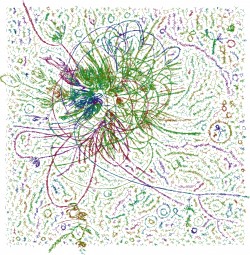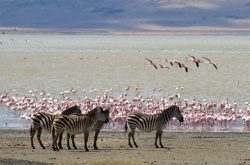How do environmental scientists unearth new discoveries about our planet? Many of us might imagine scientists observing the world around them, wading through tide pools or digging up soil. But what about questions surrounding the origins of life on Earth, or questions about microbes deep, deep within the ocean? Big questions like these require big investments, and the Simons Foundation is supporting University of Washington (UW) researchers to find some of the answers.
“UW scientists have played key roles in three Simons Collaborations — on origins of life, ocean processes and ecology, and computational biogeochemical modeling of marine ecosystems,” says Simons Foundation director of life sciences Marian Carlson. “These collaborations support interdisciplinary research at the frontiers of these fields and provide funding for high-risk science, large projects, and long-term collaborative undertakings. The Armbrust lab has also spearheaded the development of the Simons Collaborative Marine Atlas Project. Our support of research on fundamental problems in biology, ranging from the origins of life to the role of microbes in the oceans in sustaining life on Earth, will help us better understand the functioning of life on our planet.”
Ocean microbes

School of Oceanography Professor Virginia Armbrust has a long-standing relationship with the Simons Foundation and is currently co-director of the Simons Collaboration on Ocean Processes and Ecology (SCOPE) program, designed to understand microbial communities in the open ocean. She is also an investigator in the Simons Collaboration on Computational Biogeochemical Modeling of Marine Ecosystems (CBIOMES), which is developing and applying quantitative models of the structure and function of marine microbial communities.
Microbes, though tiny, sustain fundamental processes in the world’s oceans. Without microbes, the marine food web would be destroyed, greenhouse gases would not be cycled through the ocean and the world’s climate would lose one of its most significant regulators. Yet, despite accounting for more than 90 percent of the ocean’s biomass, little is known about microbes in the ocean. Funding research about microbes, measuring and modeling the distribution, composition and function of microbial communities and their interactions with the environment, are key to understanding more about fundamental processes in the ocean.
“The distinctive thing about the SCOPE program is that it’s a highly collaborative program with a focal point in sea observations, bringing together 21 principal investigators in chemical, physical and biological oceanography from institutions all over the world. The program is really on the leading edge of how oceanography could be done,” said Armbrust. “The Simons Foundation is dedicated to basic research and the power of collaborations that are cross-disciplinary.”
Within the CBIOMES program, Armbrust has taken lead on a subprogram called the Collaborative Marine Atlas Project (CMAP), which fulfills a need to centralize and organize oceanography data from satellites, sensors and other Simons projects for easy public use. The atlas pulls together synthetic analysis of complex data that were previously limited in use and organizes that data so they are accessible and usable for anyone to download and analyze. “The atlas contains more than 10 terabytes of data, all of it marked with location and time stamps to make for easy comparisons,” says Armbrust. “Cleaning up this data has been a major undertaking.”
One of Armbrust’s postdoctoral researchers, Bennett Lambert, is one of five UW postdoctoral researchers awarded the Simons Postdoctoral Fellowship in Marine Microbial Ecology, working on ways to use machine learning to examine molecular data sets available through Simons research initiatives on marine plankton. Lambert works at the intersection of machine learning and molecular ecology, using machine learning to investigate how open ocean plankton interact with their environment and each other to drive the flow of carbon in the open ocean. Using machine learning techniques he developed in the Armbrust lab, a large collection of sequences is used to describe the lifestyle of ecology of these plankton, without the need to know what each individual sequence does — the classical way of using sequences. By removing the need to know what the molecular function of each sequence is, Lambert is able to use a lot of the pieces of molecular data that were previously uninformative.
“One of the amazing things about this partnership with the Simons Foundation is having so much data that we can ask a lot of questions with it, and that we can get so much information from the open ocean, which has been hard to get due to logistics,” says Lambert, who has been trying to understand the ecology of mixotrophs in the open ocean. It is common knowledge that two types of single cell plankton exist in the ocean — zooplankton and phytoplankton — but a third type, mixotrophs, exist. Although abundant in the open ocean, very little is known about their ecology or their role in the ocean ecosystem. Organisms like this can’t be grown in the lab and previous models and datasets rarely included organisms like this, so Lambert is trying to use machine learning to discover the role that this third type of plankton plays in the microbial food web, basic information that is critical to our understanding of the open ocean ecosystem.
“I wouldn’t have the freedom to do this work, this high risk science, if not for private funding,” says Lambert. “This is one of the amazing things that the SCOPE program funding allows me to do, to take more risks in what I am able to pursue. Lots of funders don’t like to gamble as much, but I believe that really exciting science happens when you take a little bit more risk.”
Origins of life
David Catling, professor in Earth and Space Sciences, works as an investigator with the Simons Collaboration on the Origins of Life (SCOL) on another huge, unsolved question: how did life originate on Earth?
SCOL brings together 24 interdisciplinary researchers from around the world to tackle the question of how life originated. This has traditionally been a difficult subject to study, requiring expertise in biochemistry, inorganic and organic chemistry, earth sciences and astronomy for the earthly materials inherited from outer space. “I’ve been involved since 2017, when the Simons Foundation reached out to people who were specialists in the early environment of Earth. The goal is to think about the environmental context about the origin of life — what made it favorable for the simplest components of life to form, join together and then morph into the first single-celled lives?” Catling says.

This direct link between organic chemists and geologists is rare, but absolutely necessary for understanding how the building blocks of genetic molecules form and how the chemistry of water in lakes, the air, seas and oceans was conducive to the origination of life and its early spread. Although no complete answer has arisen about how life began, the collaboration is pinning down the steps by which life originated, and under what conditions. This information may also inform us about the possibility of life beyond Earth.
“This has been one of the great benefits of working with SCOL — members of this interdisciplinary group have gotten to know each other and it has created an environment where it’s ok to ask basic questions about someone else’s area of expertise” says Catling. “We’re able to break down the barriers that different lingo and jargon create for a problem that extends beyond all of our fields.”
The Simons Foundation’s grants to UW researchers over the years has totaled more than $50 million, earning them Distinguished Presidential Laureate status at the University. Without funding from private sources such as the Simons Foundation, many of these big questions in science would likely remain a mystery. In addition to providing resources to answer fundamental questions in biology, the Simons Foundation also funds researchers in mathematics and physical sciences, computational science and autism science.

